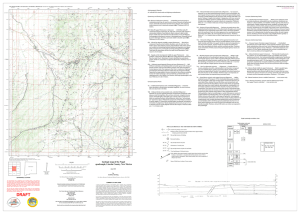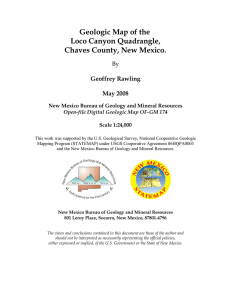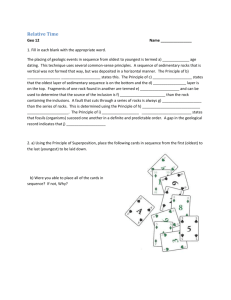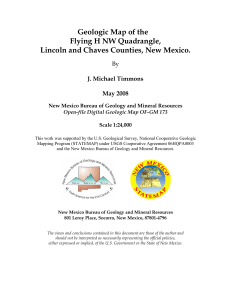Document 11090086
advertisement
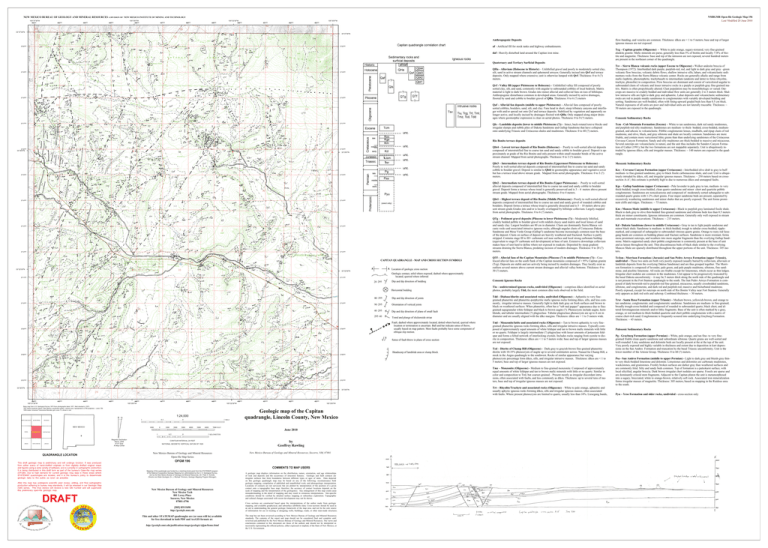
NMBGMR Open-file Geologic Map 196 Last Modified 20 June 2010 NEW MEXICO BUREAU OF GEOLOGY AND MINERAL RESOURCES A DIVISION OF NEW MEXICO INSTITUTE OF MINING AND TECHNOLOGY 105°37'30"W 442000 443000 444000 445000 105°35'0"W 446000 447000 448000 449000 105°32'30"W 450000 451000 452000 453000 105°30'0"W 33°37'30"N 33°37'30"N Anthropogenic Deposits 3720000 3720 000 af - Artificial fill for stock tanks and highway embankments. daf - Heavily disturbed land around the Capitan iron mine. Quaternary and Tertiary Surficial Deposits 3719000 3719 000 3718000 3718 000 QHa - Alluvium (Holocene to Historic) – Unlithified gravel and poorly to moderately sorted clay, silt, sand in active stream channels and ephemeral arroyos. Generally incised into Qvf and terrace deposits. Only mapped where extensive; unit is otherwise lumped with Qvf. Thickness: 0 to 4 (?) meters. Qvf - Valley fill (upper Pleistocene to Holocene) - Unlithified valley fill composed of poorly sorted clay, silt, and sand, commonly with angular to subrounded cobbles of local bedrock. Matrix material is light to dark brown. Grades into minor alluvial and colluvial fans on toes of hillslopes. Anthropogenic disturbance common in developed areas. Generally incised by active drainages, floored by sand and cobble to boulder gravel of QHa. Thickness: 0 to 6 (?) meters Qaf – Alluvial fan deposits (middle to upper Pleistocene) – Alluvial fans composed of poorly sorted cobbles, boulders, sand, silt, and clay. Fans head in short, steep tributary canyons and interfinger with and/or spread out onto Qvf and terrace deposits. Stabilized by vegetation and apparently no longer active, and locally incised by drainages floored with QHa. Only mapped along major drainages where geomorphic expression is clear on aerial photos. Thickness: 0 to 8 (?) meters. 3717000 3717 000 Qls – Landslide deposits (lower to middle Pleistocene (?)) - Intact, back-rotated toreva blocks and irregular slumps and rubble piles of Dakota Sandstone and Gallup Sandstone that have collapsed onto underlying Triassic and Cretaceous shales and mudstones. Thickness: 0 to 40 (?) meters. Rio Bonito terrace deposits 3716000 3716 000 33°35'0"N 33°35'0"N 3715000 3715 000 Qbt4 – Lowest terrace deposit of Rio Bonito (Holocene) – Poorly to well-sorted alluvial deposits composed of interstratified fine to coarse tan sand and sandy cobble to boulder gravel. Deposit is approximately at grade of the Rio Bonito and only present within small meander bends of the active stream channel. Mapped from aerial photographs. Thickness: 0 to 2 (?) meters. Qbt3 – Intermediate terrace deposit of Rio Bonito (Uppermost Pleistocene to Holocene) – Poorly to well-sorted alluvial deposits composed of interstratified fine to coarse tan sand and sandy cobble to boulder gravel. Deposit is similar to Qbt4 in geomorphic appearance and vegetative cover but has a terrace tread above stream grade. Mapped from aerial photographs. Thickness: 0 to 3 (?) meters. Qbt2 – Intermediate terrace deposit of Rio Bonito (Upper Pleistocene) – Poorly to well-sorted alluvial deposits composed of interstratified fine to coarse tan sand and sandy cobble to boulder gravel. Deposit forms a terrace whose tread is generally preserved and is 3 – 4 meters above present stream grade. Mapped from aerial photographs. Thickness: 0 to 4 meters. 3714000 3714 000 3713000 3713 000 3712000 3712 000 33°32'30"N 33°32'30"N 3711000 3711 000 Qbt1 – Highest terrace deposit of Rio Bonito (Middle Pleistocene) - Poorly to well-sorted alluvial deposits composed of interstratified fine to coarse tan sand and sandy gravel of rounded cobbles and boulders. Deposit forms a terrace whose tread is generally dissected and is 5 – 10 meters above present stream grade.Grades into and/or is locally overlapped by hillslope colluvium. Largely mapped from aerial photographs. Thickness: 0 to 6 (?) meters. QTg – Pediment gravel deposits (Pliocene to lower Pleistocene (?)) – Moderately lithified, crudely bedded pebble to boulder gravel with reddish clayey sand matrix and local lenses of sand and sandy clay. Largest boulders are 80 cm in diameter. Clasts are dominantly Sierra Blanca volcanic rocks and associated intrusive igneous rocks, although angular clasts of Cretaceous Dakota Sandstone and Mesa Verde Group (Gallup?) sandstone become increasingly common near the base of the deposit. Clasts on surface of deposit are heavily weathered and fractured. Surface is partly stripped. Contains stage III to III+ carbonate soil near surface and local strong carbonate buildup (equivalent to stage IV carbonate soil development) at base of unit. Extensive downslope colluvium makes base of unit hard to define where not exposed in roadcuts. Deposited by steep gradient streams draining the Sierra Blanca, predating incision of modern drainages. Thickness: 0 to 20 (?) meters. QTf – Alluvial fans of the Capitan Mountains (Pliocene (?) to middle Pleistocene (?)) – Coalesced alluvial fans on the south flank of the Capitan mountains composed of > 95% Capitan granite (Tcg). Deposits are stable and are actively being incised by modern drainages. They locally exist as outliers several meters above current stream drainages and alluvial valley bottoms. Thickness: 0 to 30 (?) meters. Cenozoic Igneous Rocks Tiu – undetermined igneous rocks, undivided (Oligocene) – comprises dikes identified on aerial photos, probably largely Tdd, the most common dike rock observed in the field. 3710000 3710 000 3709000 3709 000 3708000 3708 000 3707000 3707 000 33°30'0"N 33°30'0"N 442000 443000 105°37'30"W 444000 445000 446000 447000 105°35'0"W 448000 449000 105°32'30"W Base map from U.S. Geological Survey 1973 from photographs taken 1971, field checked in 1973. 1927 North American datum, New Mexico coordinate system, central zone, reprojected to UTM projection -- zone 13N 1000-meter Universal Transverse Mercator grid, zone 13, shown in red 1:24,000 WHITE OAKS SOUTH JACOB SPRING 1 ENCINOSO NEW MEXICO NOGAL ANGUS CAPITAN Capitan FORT STANTON 0.5 1000 0 0 1000 2000 3000 1 MILE 4000 5000 6000 7000 FEET CAPITAN PASS 1 LINCOLN QUADRANGLE LOCATION This draft geologic map is preliminary and will undergo revision. It was produced from either scans of hand-drafted originals or from digitally drafted original maps and figures using a wide variety of software, and is currently in cartographic production. It is being distributed in this draft form as part of the bureau's Open-file map series (OFGM), due to high demand for current geologic map data in these areas where STATEMAP quadrangles are located, and it is the bureau's policy to disseminate geologic data to the public as soon as possible. After this map has undergone scientific peer review, editing, and final cartographic production adhering to bureau map standards, it will be released in our Geologic Map (GM) series. This final version will receive a new GM number and will supercede this preliminary open-file geologic map. DRAFT Magnetic Declination March, 2008 8º 57' East At Map Center 0.5 0 450000 451000 452000 453000 105°30'0"W Geologic map of the Capitan quadrangle, Lincoln County, New Mexico June 2010 1 KILOMETER CONTOUR INTERVAL 20 FEET NATIONAL GEODETIC VERTICAL DATUM OF 1929 New Mexico Bureau of Geology and Mineral Resources Open-file Map Series by Geoffrey Rawling New Mexico Bureau of Geology and Mineral Resources, Socorro, NM, 87801 OFGM 196 COMMENTS TO MAP USERS Mapping of this quadrangle was funded by a matching-funds grant from the STATEMAP program of the National Cooperative Geologic Mapping Act, administered by the U. S. Geological Survey, and by the New Mexico Bureau of Geology and Mineral Resources, (Dr. Peter A. Scholle, Director and State Geologist, Dr. J. Michael Timmons, Geologic Mapping Program Manager). New Mexico Bureau of Geology and Mineral Resources New Mexico Tech 801 Leroy Place Socorro, New Mexico 87801-4796 [505] 835-5490 http://geoinfo.nmt.edu This and other STATEMAP quadrangles are (or soon will be) available for free download in both PDF and ArcGIS formats at: http://geoinfo.nmt.edu/publications/maps/geologic/ofgm/home.html A geologic map displays information on the distribution, nature, orientation, and age relationships of rock and deposits and the occurrence of structural features. Geologic and fault contacts are irregular surfaces that form boundaries between different types or ages of units. Data depicted on this geologic quadrangle map may be based on any of the following: reconnaissance field geologic mapping, compilation of published and unpublished work, and photogeologic interpretation. Locations of contacts are not surveyed, but are plotted by interpretation of the position of a given contact onto a topographic base map; therefore, the accuracy of contact locations depends on the scale of mapping and the interpretation of the geologist(s). Any enlargement of this map could cause misunderstanding in the detail of mapping and may result in erroneous interpretations. Site-specific conditions should be verified by detailed surface mapping or subsurface exploration. Topographic and cultural changes associated with recent development may not be shown. Cross sections are constructed based upon the interpretations of the author made from geologic mapping, and available geophysical, and subsurface (drillhole) data. Cross-sections should be used as an aid to understanding the general geologic framework of the map area, and not be the sole source of information for use in locating or designing wells, buildings, roads, or other man-made structures. The map has not been reviewed according to New Mexico Bureau of Geology and Mineral Resources standards. The contents of the report and map should not be considered final and complete until reviewed and published by the New Mexico Bureau of Geology and Mineral Resources. The views and conclusions contained in this document are those of the authors and should not be interpreted as necessarily representing the official policies, either expressed or implied, of the State of New Mexico, or the U.S. Government. Tdd – Diabase/diorite and associated rocks, undivided (Oligocene) – Aphanitic to very finegrained phaneritic and phaneritic-porphyritic mafic igneous rocks forming dikes, sills, and less commonly, irregular intrusive masses. Generally light to dark dark gray on fresh surfaces and brown to black on weathered surfaces. When phaneritic, often has a “salt and pepper” appearance due to finegrained equigranular white feldspar and black to brown augite (?). Phenocrysts include augite, hornblende, and tabular intermediate (?) plagioclase. Tabular plagioclase phenocrysts are up to 4 cm in diameter and are usually aligned with the dike margins. Thickness: dikes are < 1 to 5 meters wide. Tml – Monzonite/latite and associated rocks (Oligocene) – Tan to brown aphanitic to very finegrained phaneritic igneous rocks forming dikes, sills and irregular intrusive masses. Typically composed of approximately equal amounts of white feldspar and tan to brown mafic minerals with little or no quartz. Feldspar is largely intermediate (?) plagioclase with lesser amounts of potassium feldspar and forms a felted network of interlocking crystals. Includes rocks ranging from syenite to diorite in composition. Thickness: dikes are < 1 to 5 meters wide; base and top of larger igneous masses are not exposed. Tcd – Diorite of Champ Hill (Oligocene) - Dark gray to grayish-brown fine-grained phaneritic diorite with 10-35% phenocrysts of augite up to several centimeters across. Named for Champ Hill, a stock in the Angus quadrangle to the southwest. Rocks of similar appearance but varying phenocrysts percentage form dikes, sills, and irregular intrusive masses. Thickness: dikes are < 1 to 5 meters; base and top of larger igneous masses are not exposed. Tmz – Monzonite (Oligocene) - Medium to fine-grained monzonite. Composed of approximately equal amounts of white feldspar and tan to brown mafic minerals with little or no quartz. Similar in color and composition to Tml, but coarser-grained. . Present mostly as irregular discordant intrusions, often associated with faults, and less commonly as dikes. Thickness: up to several tens of meters, base and top of irregular igneous masses are not exposed. Trt – Rhyolite/Trachyte and associated rocks (Oligocene) – White to pale orange, aphanitic and usually aphyric igneous rocks forming dikes, sills and irregular igneous masses, often associated with faults. Where present phenocrysts are limited to quartz, usually less than 10%. Liesegang bands, flow-banding, and vesicles are common. Thickness: dikes are < 1 to 5 meters; base and top of larger igneous masses are not exposed. Tcg – Capitan granite (Oligocene) - White to pale orange, sugary-textured, very fine-grained alaskite granite. Mafic minerals are parse, generally less than 5% of biotite and locally 7-8% of biotite and magnetite. Thickness: base and top of the intrusion are not exposed, several hundred meters are present in the northeast corner of the quadrangle. Tsv – Sierra Blanca volcanic rocks (upper Eocene to Oligocene) - Walker andesite breccia of Thompson (1972). Interbedded dark purple, purplish-red, red, and light to dark gray and gray –green volcanic flow breccias, volcanic debris flows, shallow intrusive sills, lahars, and volcaniclastic sedimentary rocks from the Sierra Blanca volcanic center. Rocks are generally alkalic and range from mafic (tephrite, phonotephrite, trachybasalt) to intermediate (andesite and latite) to felsic (rhyolite, trachyte, phonolite) in composition. Flow breccias are dominant and consist of varicolored angular to subrounded clasts of volcanic and lesser intrusive rocks in a purple or purplish-gray fine-grained matrix. Matrix is often propylitically altered. Clast population may be monolithologic or varied. Outcrops are massive to crudely bedded and individual flow units are generally 2 to 3 meters thick. Shallow intrusive sills are light to dark gray and aphanitic. Lahar deposits and volcaniclastic sedimentary rocks are red to purple muddy sandstones to conglomerates with variably developed bedding and sorting. Sandstones are well-bedded, often with fining-upward graded beds less than 0.5 cm thick. Natural exposures of all units are poor and individual units are not laterally traceable. Thickness: ~ 50 meters are exposed in the quadrangle. Cenozoic Sedimentary Rocks Tcm - Cub Mountain Formation (Eocene) – White to tan sandstones, dark red sandy mudstones, and purplish-red silty mudstones. Sandstones are medium- to thick- bedded, cross-bedded, mediumgrained, and arkosic to volcaniclastic. Pebble conglomerate lenses, mudballs, and ripup clasts of red mudstone, and olive, black, and gray siltstone and shale are locally common. Sandstones are more friable, and contain more varicolored lithic grains than than underlying sandstones of the Cretaceous Crevasse Canyon Formation. Sandy and silty mudstones are thick-bedded to massive and micaceous. Several outcrops are volcaniclastic in nature, and the unit thus includes the Sanders Canyon Formation of Cather (1991), but the two formations are not mappable separately. Unit is ubiquitously intruded by igneous dikes, sills and irregular masses. Thickness: ~ 140 meters are exposed in the quadrangle. Mesozoic Sedimentary Rocks Kcc – Crevasse Canyon Formation (upper Cretaceous) – Interbedded olive drab to gray to buff medium- to fine-grained sandstone, gray to black fissile carbonaceous shale, and coal. Unit is ubiquitously intruded by dikes, sill, and irregular igneous masses. Thickness: ~ 250 meters based on crosssection A-A’; this estimate is probably high to due to numerous dikes and unmapped faults. Kgs – Gallup Sandstone (upper Cretaceous) – Pale lavender to pale gray to tan, medium- to very thick-bedded, trough cross-bedded, clean quartz sandstone and minor chert and quartzite pebble conglomerate. Sandstones are noncalcareous and composed of moderately sorted subangular to subrounded quartz grains with 1-2% chert grains. Four major sandstone beds are present, separated by recessively weathering sandstones and minor shales that are poorly exposed. The unit forms prominent cliffs and ridges. Thickness: ~ 75 meters. Km - Mancos Shale (middle to upper Cretaceous) - Black to purplish gray laminated fissile shale. Black to dark gray to olive thin-bedded fine-grained sandstone and siltstone beds less than 0.5 meters thick are minor constituents. Igneous intrusions are common. Generally only well exposed in stream cuts and manmade excavations. Thickness: ~ 215 meters. Kd - Dakota Sandstone (lower to middle Cretaceous) - Gray to tan to light purple sandstone and minor black shale. Sandstone is medium- to thick-bedded, trough to tabular cross-bedded, ripplemarked, and composed of subangular to subrounded vitreous quartz grains. Orange to rusty red liesegang bands are common on bedding planes and fracture surfaces. Sandstone is more resistant, forms more prominent outcrops, and weathers into more angular fragments than the overlying Gallup Sandstone. Matrix-supported sandy chert pebble conglomerate is commonly present at the base of unit and as lenses throughout the unit. Thin discontinuous beds of black shale similar to the overlying Mancos Shale are sparsely distributed throughout the upper portions of the unit. Thickness: 105 meters. TrJsm - Morrison Formation ( Jurassic) and San Pedro Arroyo Formation (upper Triassic), undivided – These two units are both very poorly exposed (usually buried by colluvium, alluvium or landslide deposits from the overlying Daktoa Sandstone) and are thus grouped together. The Morrison formation is composed of lavender, pale green, and pale purple mudstone, siltstone, fine sandstone, and pisolitic limestone. All rocks are friable except for limestones, which occur as thin ledges. Irregular chert nodules are common in the mudstones. Unit appear to be progressively truncated by the basal Dakota unconformity – it may be 5 meters thick along the north side of the quadrangle and is not present in the Fort Stanton quadrangle to the south. The San Pedro Arroyo Formation is composed of dark brownish-red to purplish-red fine-grained, micaceous, usually crossbedded sandstone, siltstone, and conglomerate, and dark red and purplish-red, massive and bioturbated mudstone. Poorly exposed, except for outcrops on north side of Rio Bonito Valley near Fort Stanton. Generally only appears as dark red soils and subcrop. Combined thickness: ~ 30 meters. Trsr - Santa Rosa Formation (upper Triassic) – Medium brown, yellowish-brown, and orange to tan sandstone, conglomerate, and conglomeratic sandstone. Sandstones are medium- to fine-grained, broadly trough-cross-bedded and composed of rounded to subrounded quartz, black chert, and altered ferromagnesian minerals and/or lithic fragments. Base of the unit is often marked by a gray, orange, or red medium-to thick-bedded quartzite and chert pebble conglomerate with a matrix of coarse chert-rich sand. Conglomerate is frequently scoured into underlying Grayburg Formation. Thickness: ~ 45 meters. Paleozoic Sedimentary Rocks Pg - Grayburg Formation (upper Permian) – White, pale orange, and tan fine- to very finegrained friable clean quartz sandstone and subordinate siltstone. Quartz grains are well-sorted and well-rounded. Limy sandstone and dolomite beds are locally present at the at the top of the unit. Very poorly exposed and highly variable in thickness and extent due to deposition in kart depressions on the San Andres Formation and truncation by the basal Triassic unconformity. Unit is the lower member of the Artesia Group. Thickness: 0 to 60 (?) meters. Psa - San Andres Formation (middle to upper Permian) - Light to dark gray and bluish-gray thinto very thick-bedded limestone and dolomite. Limestones and dolomites are carbonate mudstones, wackestones, and grainstones. Freshly broken surfaces are darker gray than weathered surfaces and are commonly fetid. Silty and sandy beds common. Top of formation is a paleokarst surface, with local silicified, angular breccia. Dark brown irregular chert nodules are sparse. Fossils are sparse and are dominantly crinoid stem fragments. Adjacent to the Capitan pluton the unit is metamorphosed into a sugary, brecciated, white to orange-brown, relatively soft rock. Associated iron mineralization forms irregular masses of magnetite. Thickness: 305 meters, based on mapping in the Ruidoso area to the south. Pyu – Yeso Formation and older rocks, undivided - cross-section only
